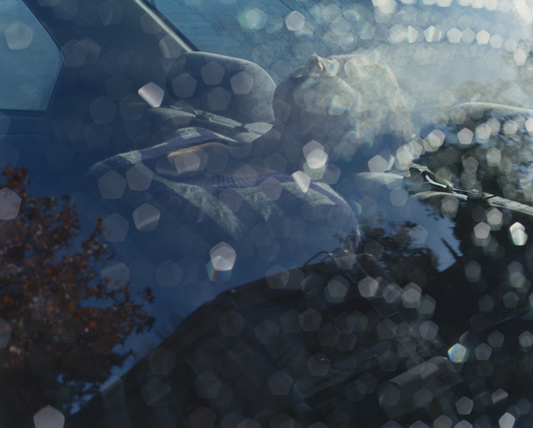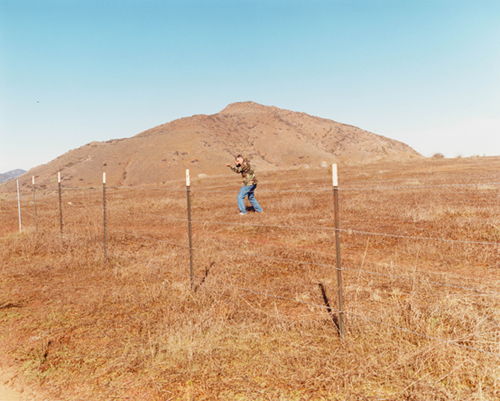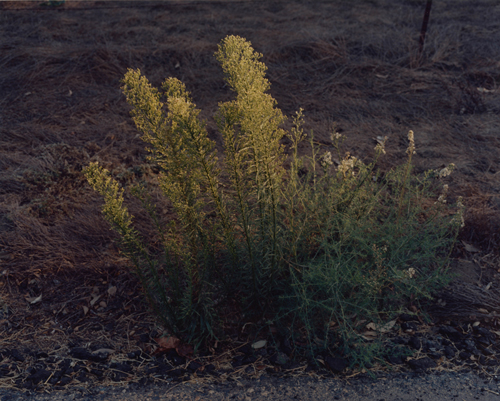Family Tree:
A Conversation with Glen Erler
by Courtney Simchak
Glen Erler discusses his debut monograph, “Family Tree,” his thoughts on family, California, photography, and what he is excited to work on next. To see more of “Family Tree,” find Newfound’s feature of Erler’s series here.
 COURTNEY SIMCHAK: How did the concept for “Family Tree” arise?
COURTNEY SIMCHAK: How did the concept for “Family Tree” arise?
GLEN ERLER: I was consciously searching for a way to put the work I was doing into a more formal context. I had always been a person who made time to visit with my family but when I moved to London, my time became more and more limited. I would normally only have a week per visit and that meant seeing as much of my family as possible within a relatively short amount of time. It was very much a discovery process. I started to see the light in California in a different way to how I saw it when I lived there. Even as a child, I remember how strong the light was and what a key role it played in how I lived my life. When you move away, you realize the impact light has on everything around you. I remember saying one day not long before I moved to London that if I woke up to another hot sunny day I wasn’t sure what I was going to do. I was literally exhausted from it. One simply took it for granted, but then I remembered the contrast of how different I felt both physically and emotionally during a rainy or even overcast period of time. It was like night and day. I can still actually feel the heaviness I carried around when the days were grey. I wanted “Family Tree” to reflect this way of life and the feeling of heat to come through in the imagery. It started off as something I was doing for myself, a way to spend time with various parts of my family but to also have something to keep close for my own children. As I continued to take the photographs, even early on, I knew it needed to be in a book format so that remained in my mind during the entire process. It went through different stages and became more and more thought through. The narrative was more than just documenting family. I was identifying with a deeper cause and what interested me most was why we all are who we are, or will become. Events happened. Some were significant and others not so significant and those thoughts and memories stayed present throughout my life thus far. Finding that reason and connection became what “Family Tree” was more about than anything else. Yes, it’s memory-based, but these memories are present in everyone’s lives, good or bad. They are why we are who we are and that’s what “Family Tree” became, not only for me but, in a way, for anyone who comes across it.
Even as a child, I remember how strong the light was and what a key role it played in how I lived my life. When you move away, you realize the impact light has on everything around you.”
–Glen Erler
SIMCHAK: “Family Tree” is your first monograph to be released. Why did you want to compose this series of photographs in book format? What joys and challenges have you experienced while photographing and assembling your monograph?
ERLER: I’m attracted to the permanence of books. Because I print my own work, there’s also a sense of permanence to each printed image but a book takes it a step further.
“Family Tree” wasn’t/isn’t a lighthearted piece of work. There was a great deal of thought put into the image making followed by the actual book making process, the design, paper stock, printing, etc….
It was something that was a big part of the reason I was making the work. My kids will have it to look back on. They were born in London but have a real attachment to California. Their family is there and they don’t get to spend much time with them, so this book will always be there for them and will help them have and form their own memories as time goes by.
I found the entire process of making the work and then also making the book a very positive experience. There is a certain amount of self discovery that happens along the way. I started making the images for “Family Tree” as one person and with all that happened during the process, I would say partially became another. The death of my father had a huge impact on me. He and I always had a very close relationship. He had a very bad childhood with both of his parents passing away within months of each other when he was only 13. He told me that there wasn’t much love shown to him or any of his siblings, ever. I think that stayed with him and haunted him until his death. I also think he made sure that I knew he loved me and was always there for me and I think this came from his past experience and childhood and by wanting more for me. I don’t think he ever dealt with it on a level that would have saved him or helped him later in life, and I think his way of dealing with it was to push it down, but that could have been due to him thinking that’s just what men do, especially from that generation. Most memories have the ability to linger, but may come and go. They are often triggered by something that in turn brings them back to mind. I still find it surreal that my father is gone. Memories of him and the time he and I spent together, even as a young boy, are still very present and feel different to other forms of memories, be it other parts of childhood or even something that happened last week. It’s very different. I carry them in different ways, but I’m yet to find it easy.

SIMCHAK: What is your source of inspiration for your compositions?
ERLER: I tend to look at picture taking along the lines of painting or film making to a certain extent. To me, it’s a controlled environment I like working within and I prefer to have the choice of moving things in and out of frame according to what works for me personally. I tend to have a set of rules I follow and try to stick to them as much as possible. There are always things one can’t entirely control, but if something is not right and I have the ability to change it to my liking, I do. Otherwise, it’s documenting and I felt it was important to take this body of work further than that whenever possible.
The construction aspect of the images in “Family Tree” became more and more important as the project went on. It was simply a conscious part of the picture taking process. The camera I use and also the fact that I work on film adds to a rather slow and thoughtful way of doing things yet I never felt as though I was sitting waiting. It was a proactive process with time constraints involved so everything within the frame had to be considered and thought through in a relatively short amount of time. I would often see something and then bring it to life so to speak. There was always a starting point that would then end with adjustments made within the framing. There was less of that in the beginning when it was more about seeking out places where things happened. Less needed to be done at that point.
SIMCHAK: Your photo compositions are fairly complicated and utilize multiple layers of light, texture, color, and depth. You have mentioned in previous interviews that your compositions are carefully constructed, sometimes well before you’re on site, both out of necessity and design. When planning your compositions do you gather mental clues over time, or you do plan your images all at once?
ERLER: It all depends on the image. It’s happened in different ways and I feel I need to be open to spontaneity but I try to put things together in my mind as much as possible before starting, mostly as I enjoy that part of the process. There are parts of my work in “Family Tree” and elsewhere that were simply there in front of me and nothing needed to be done to make them a better picture and are equally important. However, mostly when working with people, I prefer to make the images into something more than just finding or waiting for someone to do something interesting. It works better for me.
The narrative was more than just documenting family. I was identifying with a deeper cause and what interested me most was why we all are who we are, or will become…Finding that reason and connection became what “Family Tree” was more about than anything else.”
–Glen Erler
SIMCHAK: Do you feel your work on “Family Tree” has changed you? How so?
ERLER: I touched on this earlier, and I do feel that over time one naturally changes or evolves anyway, but yes, I think it changed me. I think it’s still changing me. There was a certain amount of asking myself questions in why I was making these images and what needed to come from it on a personal level. Those questions were answered as a part of the evolution of the project but I didn’t really spend much time dwelling on them. I know far more now after having sat with “Family Tree” as a finished piece of work and after being asked questions than I did while I was making the work.
When examining one’s family though, and all that happens from point A to point B, that change can be more significant depending on the weight of what has happened in that person’s life and also how they are wired to deal with it. It just so happens that I had several things that happened early on that stayed with me. I’m not sure if they were positive or negative but they stayed. These events made me wonder about other people and what had happened, if anything, that caused change and in the case of “Family Tree,” other parts of my own family. I didn’t seek out everything or everyone but mostly those who I spent time with growing up. I was immersed in the thought process of this as a theme so to delve into such things is naturally going to cause change. Again, the death of my father ended the project and in turn changed me the most out of any of the other events. I’m still questioning this of which seems more like the beginning of new thoughts compared to the ending of a chapter.

SIMCHAK: Have you always been interested in the arts?
ERLER: Not always. It seemed to have started around my mid twenties and from then it has become more and more important to me.
I think I’m drawn to always feeling that it can be better. I can see the evolution and growth through the years, but I’m still wanting it to be better and to find the missing link. I don’t know where this comes from or where it stops. Hopefully, I’ll know when and if it happens.
I’m attracted to several other forms of expression and admire anyone who can lose themselves in what they’re doing. If it comes from a personal and soulful place, that will show through and I personally tend to be drawn to it, no matter the medium.
SIMCHAK: What are you enjoying most about the work you are doing currently?
ERLER: I started working on a project near the end of “Family Tree” that took me to another place. I had been working so often with family and friends with Family Tree and also a few other projects I had done along the way that I felt it was time to branch out and to move outside of my comfort zone. I don’t want to go to into detail at this point but I’ll say I ventured into new territory in ways, not technically but on a different emotional level. It was challenging and interesting to work with people who I had no connection to and to take them and the work to places that challenged our boundaries as strangers so to speak.
I’m also working on a commission with a singer/songwriter at the moment called Marika Hackman. She’s incredibly talented and I’m thoroughly enjoying the process. She has given me a tremendous amount of freedom where we’ll be piecing together the images I’ve done with and without her presence over a two-month period. We’re nearing the end so it’s an exciting time.
I feel as though I’m still learning and growing and very much hope I can continue to make photographs for some time to come. Again, it’s not easy and only time will tell.

SIMCHAK: Oscar Wilde once said, “Every portrait that is painted with feeling is a portrait of the artist, not of the sitter.” Do you think photography functions as a kind of collective self-portrait of the photographer?
ERLER: In my case, I do think I photograph people how I would prefer to be photographed. I don’t personally like to be photographed very much and I tend to hide my subjects to a certain extent so perhaps there is a connection. To me, it’s not only about the person in the photograph, it’s about the person including everything else within the frame as well. It’s equal and each element is as important as the other. If one element within the frame isn’t right, it can distract from the other elements. So in my case, I’m possibly reaching deep inside to find the meaning of several things in my life and perhaps my work reflects this in my approach and can be considered a self portrait in many ways. I see what I see because of my own experience and that translates into the finished image. I’m piecing things together in my life and therefore doing my best to piece things together in my work as well.
SIMCHAK: What do you believe has influenced your personal aesthetic the most?
ERLER: There are people’s work that I admire but I feel it’s more important to find and keep a hold on one’s own voice. Making “Family Tree” was vital in helping to find that. It’s something that can take a lifetime to figure out and to achieve and I may still have a ways to go but I’ve really enjoyed the freedom of making work that feels as though it’s my own. I made it from a very personal place so it would be hard to call it anything else.

Courtney Simchak, Visual Arts Editor

0 comments on “Interviews: Glen Erler”